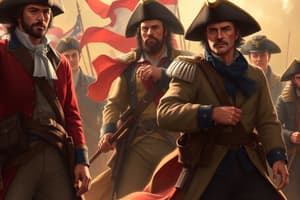Podcast
Questions and Answers
Who was known for applying guerrilla tactics during the war?
Who was known for applying guerrilla tactics during the war?
- Francis Marion (correct)
- Marquis de Lafayette
- Cornwallis
- John Paul Jones
The Treaty of Paris stated that the USA would be dependent on England.
The Treaty of Paris stated that the USA would be dependent on England.
False (B)
What was Benedict Arnold known for during the war?
What was Benedict Arnold known for during the war?
He was a patriot who later became a traitor after marrying a loyalist.
The British general who surrendered at Yorktown was ______.
The British general who surrendered at Yorktown was ______.
Match the following individuals with their roles during the war:
Match the following individuals with their roles during the war:
What percentage of colonists were loyalists at the beginning of the war?
What percentage of colonists were loyalists at the beginning of the war?
George Washington's strategy was to engage in formal battles with the British.
George Washington's strategy was to engage in formal battles with the British.
What was the role of a privateer?
What was the role of a privateer?
What was a significant outcome of the Battles of Saratoga?
What was a significant outcome of the Battles of Saratoga?
The colonists received support from Spain, but not from France or Germany.
The colonists received support from Spain, but not from France or Germany.
Who helped train the Continental Army and was a key figure from Germany?
Who helped train the Continental Army and was a key figure from Germany?
The Continental Army won largely due to the leadership of ______ and their understanding of the land.
The Continental Army won largely due to the leadership of ______ and their understanding of the land.
Match the following individuals with their contributions during the Revolutionary War:
Match the following individuals with their contributions during the Revolutionary War:
What was one of Cornwallis’ major mistakes during the war?
What was one of Cornwallis’ major mistakes during the war?
What were the conditions like for soldiers at Valley Forge?
What were the conditions like for soldiers at Valley Forge?
Guerrilla fighting involved direct and open battles with the British troops.
Guerrilla fighting involved direct and open battles with the British troops.
Flashcards
Loyalist
Loyalist
A colonist loyal to the British King during the American Revolution.
Patriot
Patriot
A colonist supporting the American cause during the American Revolution.
Mercenary
Mercenary
A soldier paid to fight in a foreign army.
Washington's Strategy
Washington's Strategy
Signup and view all the flashcards
British Strategy
British Strategy
Signup and view all the flashcards
Early Colonial Support
Early Colonial Support
Signup and view all the flashcards
Treaty of Paris
Treaty of Paris
Signup and view all the flashcards
Guerrilla Warfare
Guerrilla Warfare
Signup and view all the flashcards
Battles of Saratoga
Battles of Saratoga
Signup and view all the flashcards
European Aid to Colonists
European Aid to Colonists
Signup and view all the flashcards
Valley Forge
Valley Forge
Signup and view all the flashcards
British Southern Strategy
British Southern Strategy
Signup and view all the flashcards
Guerrilla Warfare
Guerrilla Warfare
Signup and view all the flashcards
Cornwallis' Mistake at Yorktown
Cornwallis' Mistake at Yorktown
Signup and view all the flashcards
Treaty of Paris
Treaty of Paris
Signup and view all the flashcards
Continental Army's Success Factors
Continental Army's Success Factors
Signup and view all the flashcards
Study Notes
Key Figures and Terms
- Loyalist: Colonist loyal to the English King.
- Patriot: Supported the American cause.
- Mercenary: Paid soldier serving a foreign country.
- Burgoyne: British general, slow, surrendered at Saratoga.
- St. Leger: British commander, deterred by Patriot intelligence.
- Howe: British general, diverted to Pennsylvania.
- Benedict Arnold: Patriot turned traitor.
- Marquis de Lafayette: French aristocrat, allied with Washington.
- Baron Von Steuben: German soldier, trained Continental Army.
- George Rogers Clark: "George Washington of the West," frontiersman.
- Privateer: Privately owned armed ship.
- John Paul Jones: Famous naval commander.
- Francis Marion: "Swamp Fox," used guerrilla tactics.
- Cornwallis: British general, surrendered at Yorktown.
- Nathanael Greene: Quaker general, led Southern campaign.
- Treaty of Paris: Ended the Revolutionary War.
Section 1: Early Years
- Colonial Support: In 1776, 20% Loyalists, 40% neutral, 40% Patriots; most colonists favored avoiding war.
- Strategies: Washington aimed to prove American resolve; British preferred marching formations. Patriot strategy focused on smaller, unexpected attacks.
- Saratoga: Three British armies planned to meet in Albany. Only Burgoyne's army reached Saratoga; his defeat boosted Patriot credibility and attracted foreign support.
Section 2: War Expands
- European Aid: France sent 6,000 troops under Marquis de Lafayette; Baron von Steuben trained the Continental Army; Polish soldiers (Kosciuszko & Pulaski) assisted in fortifications; and Spanish support was crucial in the South.
- Valley Forge: Harsh winter encampment, shortages of food, clothing, and supplies; disease and starvation significantly affected the Continental Army. British also stole supplies from colonists.
Section 3: Path to Victory
- Southern Focus: British shifted focus to the South, hoping to secure loyalist support, and utilizing supply lines in the Caribbean.
- Guerrilla Warfare: American advantage using the knowledge of the area; small, surprise attacks, and quick retreats; utilized terrain to the patriot's benefit.
- Cornwallis' Mistake: Cornwallis's movement to Yorktown, a peninsula, led to his entrapment and surrender; French naval intervention was a key factor.
Section 4: Legacy
- Winning Factors: Continental Army's dedication, leadership of George Washington, home-field advantage, knowledge of the territory, and international support combined to defeat British forces.
- Treaty of Paris Provisions:
- United States recognized as independent.
- Set boundaries: Mississippi River, Canada, and Florida.
- US fishing rights in Canadian waters.
- Resolution of financial debts between the two countries.
- British required to return escaped slaves.
- Loyalist property rights to be recognized.
Studying That Suits You
Use AI to generate personalized quizzes and flashcards to suit your learning preferences.




